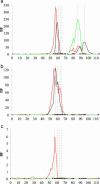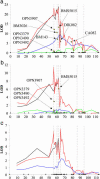Fine-mapping milk production quantitative trait loci on BTA6: analysis of the bovine osteopontin gene
- PMID: 15867146
- PMCID: PMC1100795
- DOI: 10.1073/pnas.0502398102
Fine-mapping milk production quantitative trait loci on BTA6: analysis of the bovine osteopontin gene
Abstract
Bovine chromosome six (BTA6) harbors up to six quantitative trait loci (QTL) influencing the milk production of dairy cattle. In stark contrast to human, there is long-range linkage disequilibrium in dairy cattle, which has previously made it difficult to identify the mutations underlying these QTL. Using 38 microsatellite markers in a pedigree of 3,147 Holstein bulls, we fine mapped regions of BTA6 that had previously been shown to harbor QTL. Next, we sequenced a 12.3-kb region harboring Osteopontin, a positional candidate for the statistically most significant of the identified QTL. Nine mutations were identified, and only genotypes for the OPN3907 indel were concordant with the QTL genotypes of eight bulls that were established by segregation analysis. Four of these mutations were genotyped, and a joint linkage/linkage disequilibrium mapping analysis was used to demonstrate the existence of only two functionally distinct clusters of haplotypes within the QTL region, which were uniquely defined by OPN3907 alleles. We estimate a probability of 0.40 that no other mutation within this region is concordant with the QTL genotypes of these eight bulls. Finally, we demonstrate that the motif harboring OPN3907, which is upstream of the promoter and within a region known to harbor tissue-specific osteopontin regulatory elements, is moderately conserved among mammals. The motif was not retrieved from database queries and may be a novel regulatory element.
Figures




Similar articles
-
The bovine PPARGC1A gene: molecular characterization and association of an SNP with variation of milk fat synthesis.Physiol Genomics. 2005 Mar 21;21(1):1-13. doi: 10.1152/physiolgenomics.00103.2004. Physiol Genomics. 2005. PMID: 15781588
-
Fine mapping of a QTL on bovine chromosome 6 using imputed full sequence data suggests a key role for the group-specific component (GC) gene in clinical mastitis and milk production.Genet Sel Evol. 2016 Oct 19;48(1):79. doi: 10.1186/s12711-016-0257-2. Genet Sel Evol. 2016. PMID: 27760518 Free PMC article.
-
The concordance test emerges as a powerful tool for identifying quantitative trait nucleotides: lessons from BTA6 milk yield QTL.Anim Genet. 2009 Apr;40(2):230-4. doi: 10.1111/j.1365-2052.2008.01809.x. Epub 2008 Nov 11. Anim Genet. 2009. PMID: 19016682
-
Effects of the osteopontin gene variants on milk production traits in dairy cattle.J Dairy Sci. 2005 Nov;88(11):4083-6. doi: 10.3168/jds.S0022-0302(05)73092-7. J Dairy Sci. 2005. PMID: 16230712
-
Fine mapping of milk production QTL on BTA6 by combined linkage and linkage disequilibrium analysis.J Dairy Sci. 2004 Mar;87(3):690-8. doi: 10.3168/jds.S0022-0302(04)73212-9. J Dairy Sci. 2004. PMID: 15202654
Cited by
-
Association of SPP1 and NCAPG genes with milk production traits in Chinese Holstein cows: polymorphism and functional validation analysis.Front Vet Sci. 2024 Oct 30;11:1435128. doi: 10.3389/fvets.2024.1435128. eCollection 2024. Front Vet Sci. 2024. PMID: 39545257 Free PMC article.
-
Whole genome linkage disequilibrium maps in cattle.BMC Genet. 2007 Oct 25;8:74. doi: 10.1186/1471-2156-8-74. BMC Genet. 2007. PMID: 17961247 Free PMC article.
-
A radiation hybrid map of river buffalo (Bubalus bubalis) chromosome 7 and comparative mapping to the cattle and human genomes.Cytogenet Genome Res. 2007;119(3-4):235-41. doi: 10.1159/000112067. Epub 2008 Feb 1. Cytogenet Genome Res. 2007. PMID: 18253035 Free PMC article.
-
DGAT1 and ABCG2 polymorphism in Indian cattle (Bos indicus) and buffalo (Bubalus bubalis) breeds.BMC Vet Res. 2006 Nov 7;2:32. doi: 10.1186/1746-6148-2-32. BMC Vet Res. 2006. PMID: 17087837 Free PMC article.
-
Using an evolutionary algorithm and parallel computing for haplotyping in a general complex pedigree with multiple marker loci.BMC Bioinformatics. 2008 Apr 11;9:189. doi: 10.1186/1471-2105-9-189. BMC Bioinformatics. 2008. PMID: 18405361 Free PMC article.
References
-
- Grisart, B., Coppieters, W., Farnir, F., Karim, L., Ford, C., Berzi, P., Cambisano, N., Mni, M., Reid, S., Simon, P., et al. (2002) Genome Res. 12, 222–231. - PubMed
-
- Bovenhuis, H. & Schrooten, C. (2002) Proceedings of the 7th World Congress on Genetics Applied to Livestock Production, Communication No. 09–07, August 19–23, 2002 (7WCGALP, Montpellier, France).
MeSH terms
Substances
Associated data
- Actions
LinkOut - more resources
Full Text Sources
Other Literature Sources
Molecular Biology Databases
Research Materials
Miscellaneous

